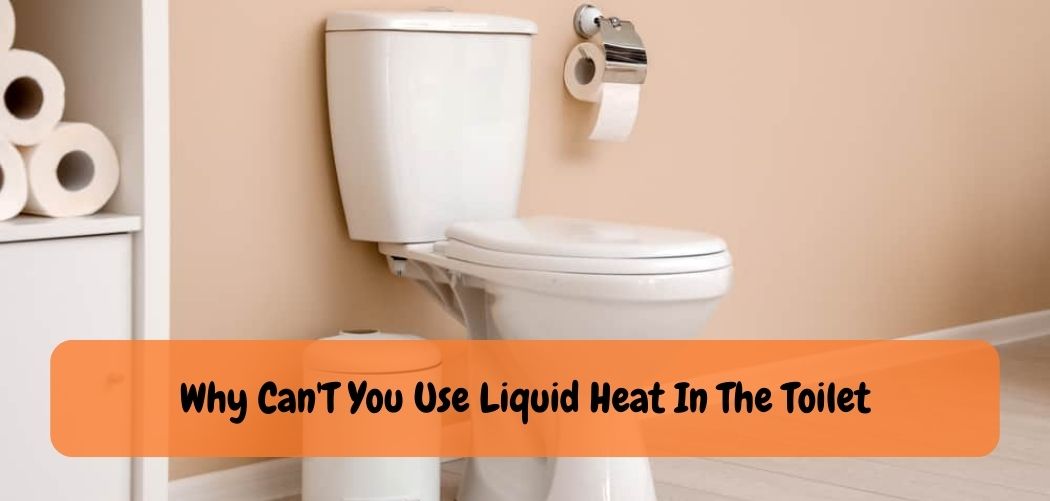Why Liquid Heat Spells Disaster for Your Toilet: Learn the Science Behind it

Liquid heat, a drain-cleaning product, should not be used in the toilet because of its highly caustic nature. The product can cause damage to the porcelain and disintegrate rubber and plastic components in the toilet.
Have you ever wondered why you can’t simply use “liquid heat” to unclog a stubborn toilet, despite its seemingly potent-sounding name? While the idea of a powerful liquid capable of dissolving blockages might sound appealing, there’s more to plumbing and chemistry than meets the eye.
In this exploration, we’ll delve into the reasons why using certain types of liquid solutions, often advertised as “liquid heat” or similar, can be problematic when attempting to unclog a toilet. Understanding the science behind these substances.
The intricacies of plumbing systems, and the potential risks involved can help us make more informed decisions when dealing with toilet blockages and other plumbing issues. Let’s uncover the facts and reasons behind the limitations of using “liquid heat” in the toilet.
Understanding The Composition Of Liquid Heat
Liquid heat is a popular unclogging product, but it’s important to understand its composition before use. Liquid heat is a chemical mixture that’s designed to dissolve substances such as grease, hair, and other organic materials that clog pipes.
Its main components are sodium hydroxide and sodium hypochlorite, both of which can cause skin and eye irritation. When liquid heat is poured into a toilet, a chemical reaction occurs that generates heat and gas, which helps to break down the organic materials in the clog.
However, it’s important to note that liquid heat should never be used in toilets that are connected to a septic system since it can disrupt the natural bacteria. Always follow the instructions and use precautions when using liquid heat.
The Smart Guide: Can’T You Use Liquid Heat In The Toilet
When facing a clogged toilet, the allure of a quick fix in the form of “liquid heat” or similar chemical solutions can be tempting. However, plumbing systems and the interactions between various substances within them are more intricate than they appear.
In this informative guide, we’ll explore the reasons why using “liquid heat” in the toilet can be problematic, shedding light on the science behind plumbing, the potential risks involved, and the alternatives to effectively deal with toilet clogs while maintaining safety and protecting your plumbing system.
Chapter 1: Understanding the Nature of Clogs
- Explore the common causes of toilet clogs, from excessive toilet paper to foreign objects.
- Discuss the factors that contribute to the severity of a clog and the importance of correctly identifying the source of the blockage.
The Chapter 2: The Composition of “Liquid Heat”
- Analyze the chemical composition of typical “liquid heat” products marketed for unclogging drains.
- Examine the primary active ingredients in these solutions, including their intended mechanisms of action.
Chapter 3: Reaction with Organic and Inorganic Matter
- Discuss how “liquid heat” interacts with organic materials commonly found in toilet clogs.
- Highlight the potential reactions between “liquid heat” and inorganic substances, such as the minerals in water or the toilet bowl material.
Chapter 4: The Impact on Plumbing Systems
- Explore the potential corrosive effects of “liquid heat” on plumbing pipes and components.
- Discuss how prolonged use of these chemicals can damage the plumbing system, leading to costly repairs.
The Chapter 5: Safety Considerations
- Examine the safety risks associated with using “liquid heat” in the toilet, including potential skin and eye irritation.
- Discuss the importance of proper ventilation and protective equipment when working with chemical solutions.
Chapter 6: Effective and Safe Alternatives
- Introduce safer alternatives for dealing with toilet clogs, such as plungers, augers, and natural enzymatic drain cleaners.
- Highlight the benefits of preventive measures, regular maintenance, and responsible usage of the toilet to avoid clogs.
Also Read: Toilets with No Tank in 2023 | Tankless Toilet Reviews
Why Liquid Heat Is Not Ideal For Unclogging Toilets
Liquid heat is a popular solution for unclogging toilets, but it’s not always the ideal choice. Using liquid heat frequently can damage toilets and cause them to deteriorate faster.
Additionally, liquid heat can pose risks to human health and the environment due to the harsh chemicals it contains. To avoid these risks and maintain your toilet’s longevity, alternative and safer methods such as using a plunger or a plumbing snake are recommended.
These methods are effective in breaking down and removing clogs without causing harm to your toilet or the environment. By avoiding liquid heat and using alternative methods, you can keep your toilet in good condition and avoid any unnecessary expenses.
Frequently Asked Questions For Why Can’T You Use Liquid Heat In The Toilet?
Answer:
Only flush toilet paper and human waste, avoid flushing objects like wipes, toys, and dental floss to prevent clogs and costly repairs.
Conclusion
As we can see, using liquid heat in the toilet can do more harm than good. It might temporarily unclog the pipes but that can lead to bigger problems in the long term. Such products can damage the porcelain of the toilet bowl, the interior of the pipes or even cause chemical burns if used improperly.
Additionally, the toxic chemicals from liquid heat can harm the environment and pose a danger to our health. Therefore, it’s important to avoid using such products and opt for safer alternatives like a plunger or a plumber’s snake. Regular maintenance of the toilet and avoiding flushing non-biodegradable items down the drain can prevent clogs from happening in the first place.
Remember, prevention is always better than cure. By following these simple tips, you can keep your toilet clog-free and reduce the risk of costly repairs.
